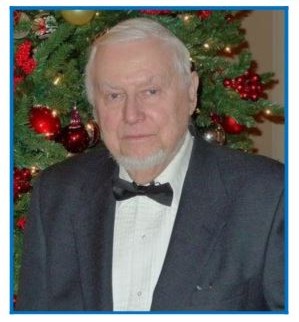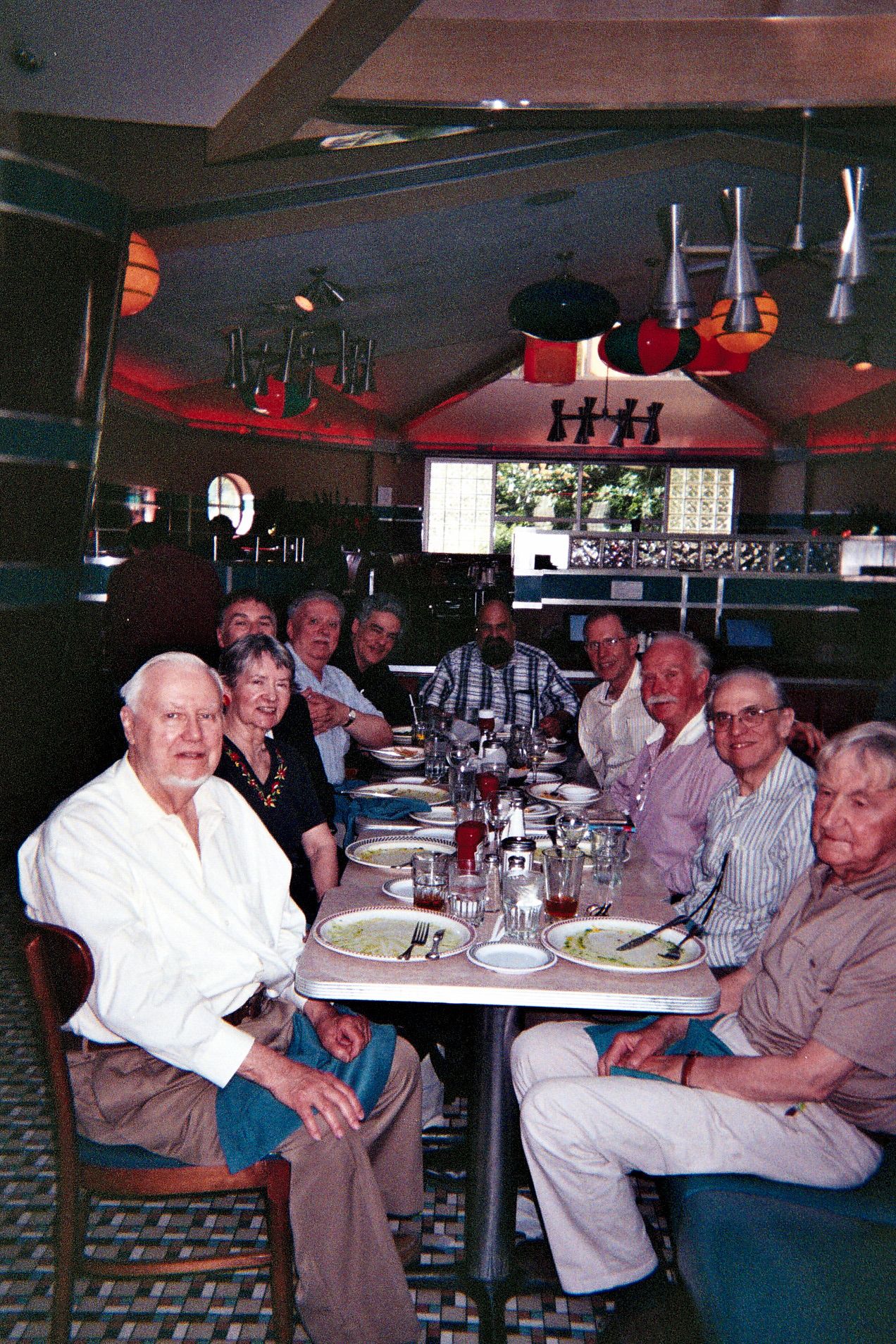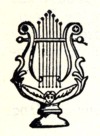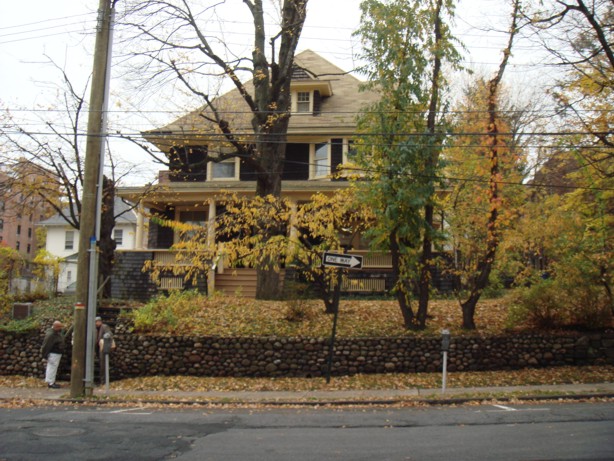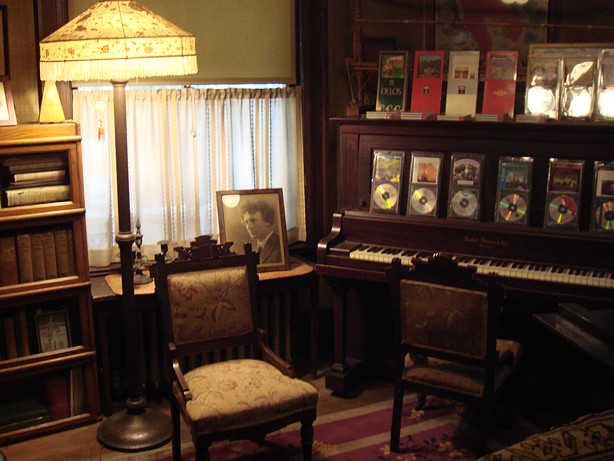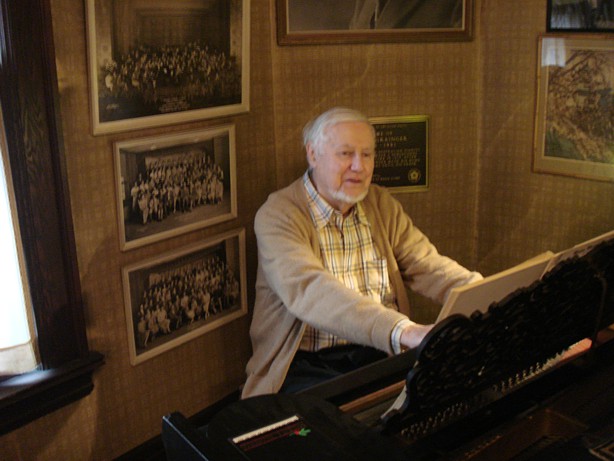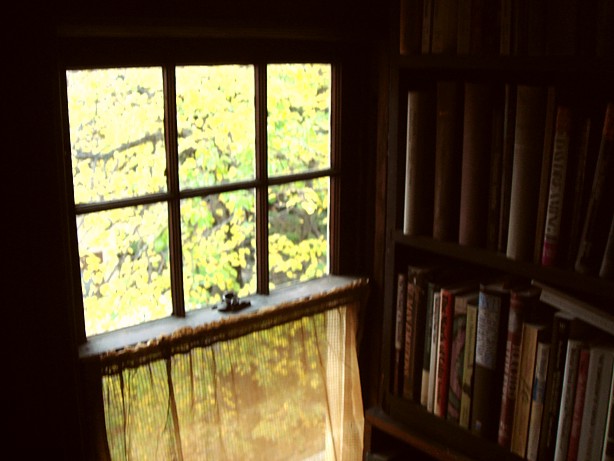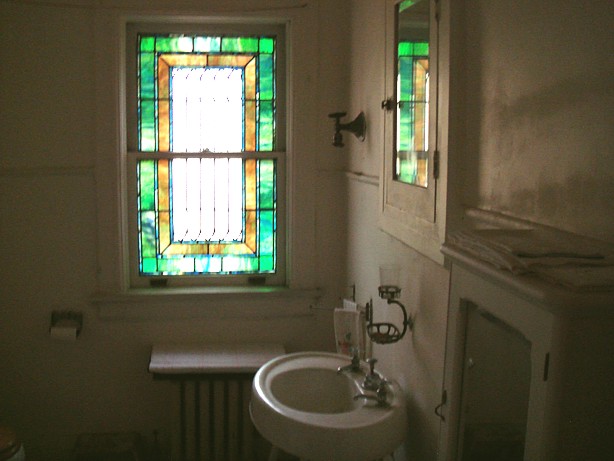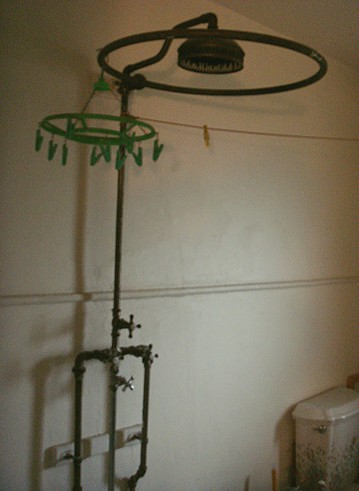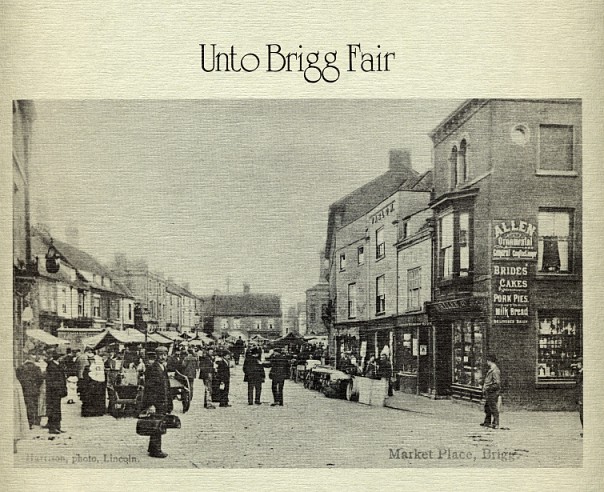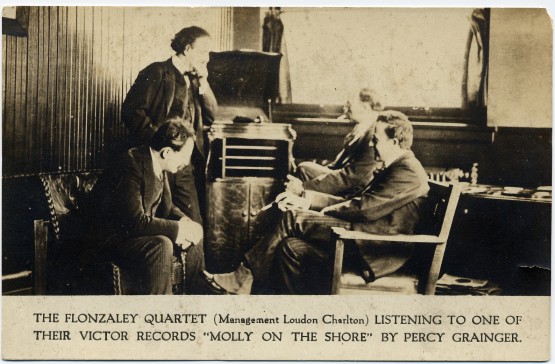
|
FILMS! LIVE PERFORMANCES! COMMENTARY! |

International Percy Grainger Society
|
|
|
Grainger house virtual tour |
A spacious Victorian home
Since the Society is headquartered in Grainger's actual house in White Plains, an important part of the site is devoted to a pictorial tour of the house, where we hope that visitors will feel that they are welcome guests of Percy and Ella.
The Grainger house is a spacious late Victorian house (1893), literally from the "gaslight" era--the gas light fixtures are still there! To it, Percy added his own original enhancements, such as an enlarged window in the living room to let in sunshine, fireproof vaults in the basement, and an exercise bar over the living room doorway.
Artifacts, such as Percy's pianos, an Edison cylinder recorder, and the wheelbarrow in which he wheeled his music to the train station en route to his performances, can still be seen.
The basement vaults contain manuscripts and copies of the composer's works, as described below.
Take the tour
A virtual "guided tour" of the Grainger house on this Web site can be taken by clicking on Grainger house or on the accompanying picture.

Is the Grainger House haunted?
Strange manifestations have been seen at 7 Cromwell. Moving lights have been caught on camera, objects have moved on their own, and some have thought they felt the presence of Percy himself! For pictures, see The Haunted House below.
The Grainger archives |
Fireproof basement vaults
Percy Grainger designed special fireproof vaults in his basement to store his manuscripts. The small picture shows the opening bars of one of his compositions. Click on the name Hill Song No. 1 or on the image for information on the Grainger Archives.

JOIN THE INTERNATIONAL PERCY GRAINGER SOCIETY!We invite you to become members of the International Percy Grainger Society. Keep alive the legacy of this great musical innovator. We are making plans for new activities at the Grainger House. For details of membership, go to the Membership Page. We also have a new Facebook page. If you wish to gain access to this, please send a FB friend request to Barry Peter Ould. |
AVAILABILITY OF SCORES AND PARTS
NEW PHONE NUMBER AND WEBSITE
NEW NUMBER FOR DETAILS ABOUT THE INTERNATIONAL PERCY GRAINGER SOCIETY: (914) 281-1610.
MATTERS RELATING TO COPYRIGHT, PERMISSIONS AND GENERAL ENQUIRIES REGARDING GRAINGER'S MUSIC SHOULD BE SENT IN AN EMAIL TO: info@percygrainger.org.uk
PLEASE ALSO CHECK OUT OUR NEW MEMBER ORIENTED WEBSITE AT:
http://www.percygraingeramerica.org
HOPING TO HEAR FROM YOU!
|
NEWS, JULY, 2015: SOME NEW OFFICERS AND A NEW DUES ARRANGEMENTOn July 26, the Board of Trustees met at the Grainger House. Our number has increased with the addition of two wonderful people. Barry Peter Ould, of Bardic Edition Music Publishers, who has published many of Grainger's works, is now President. Rolf Stang, one of our stalwart founders, who always keeps us energized, is now President Emeritus. Susan Edwards Colson, attorney and philanthropic advisor, is now Vice President and General Secretary. Mark Grant also continues as Vice President. At the meeting, Rolf was presented with a certificate of appreciation for all he has done to make everyone aware of Percy's legacy. Stewart Manville, our forever Archivist and Curator, was also presented with a certificate lauding his contributions. We also discussed the new dues structure for the Society, as described in the box above. After the meeting, we adjourned to the nearby City Limits diner for lunch. Below are a picture of Stewart receiving his award, taken by Matt McGarrell, and a picture of the group at lunch, which our waiter was kind enough to take.

Left to right: Barry Ould, Rolf Stang, Cora Sowa, John Sowa, Mark Grant, Matt McGarrell, Eric Culver, Susan Edwards Colson. |
NEWS: A GREAT VIDEO OF THE GRAINGER HOUSE ON YOUTUBEThere's a great video on YouTube of a visit to the Grainger House. Go to https://www.youtube.com/watch?v=fAN92s46PO8 |
NEWS FROM SPRINGDALE, ARKANSAS: PERCY GRAINGER HAS BIG-TIME FANS IN THE OZARKS (JUNE, 2014)by Cora SowaThe week of June 10-15, 2014, I had the good fortune to attend the annual convention of the National Railway Historical Society in Springdale, Arkansas, where we went on rail excursions and took plenty of photographs of short lines in the region. The evening of June 13, there was a banquet, preceded by a social hour where we were entertained by a quartet of saxophone players. They turned out to be students from Springdale High School and their teacher, Daniel Hodge (who switched from alto to soprano sax at one point in their performance). As they concluded their set, I asked if they ever played Percy Grainger. They do, big time! Mr. Hodge told me that they play, among other pieces, Handel in the Strand, Tune from County Derry, and Lincolnshire Posy. They have purchased a copy of our LP of the Lincolnshire songs recorded by Grainger, which they have in their library. Mr Hodge and his students graciously posed for their picture, which you see below. So next time you think of high school bands playing Grainger, think of Springdale, Arkansas.
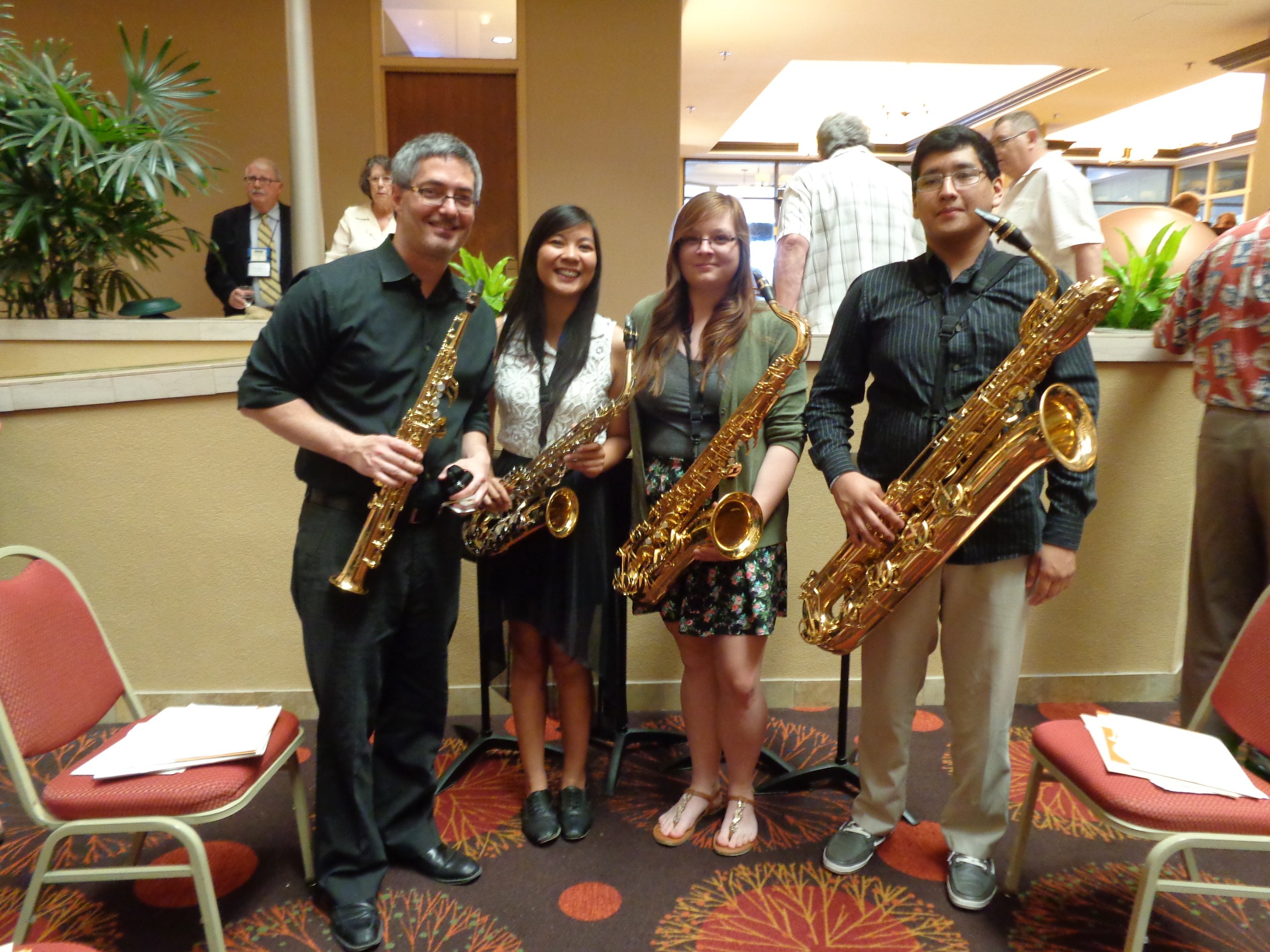
|
ASTRONOMICAL NEWS! PERCY GRAINGER IS A CRATER ON MERCURY!In 2012, the U.S. Geological Survey (USGS) and NASA approved the name "Grainger," named after Percy Grainger, for one of the craters on the planet Mercury. Other names approved include "Holst," "Ellington," and "Sousa." To see more about them, go to
Below is a picture showing Crater Grainger: 
Percy Grainger's crater on the planet Mercury. |
HEAR A PERFORMANCE OF GRAINGER'S FREE MUSIC FOR THEREMINYou can hear Thorwald Jørgensen, Marieke van der Heyden, Marcel Wierckx, and Jessica Hummel play Grainger's Free Music No.1 for Four Theremins on YouTube. |
PICTURES FROM THE WHITE PLAINS GRAINGER CELEBRATION, FEBRUARY 20, 2011We have a few pictures taken at the Celebration of the Life and Music of Percy Grainger, performed under the excellent direction of Vincent Lionti, violist with the Metropolitan Opera Orchestra, held on February 20, 2011 at Grace Episcopal Church in White Plains. The group included two violins, one viola (Mr. Lionti), cello, and piano. We hope eventually to be able to bring you audio clips of some of the music that was played, which included an extraordinarily beautiful interpretation of Grainger's Free Music No. 1 as realized for strings.
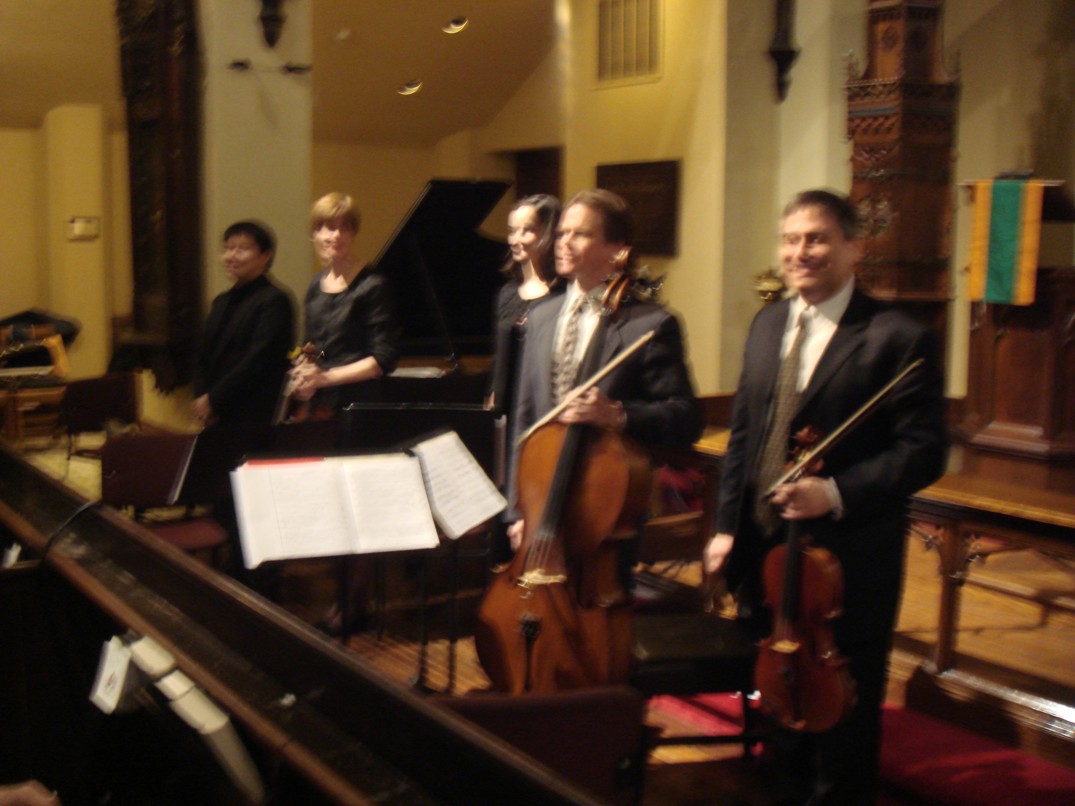
Vincent Lionti (on the right) and fellow musicians. 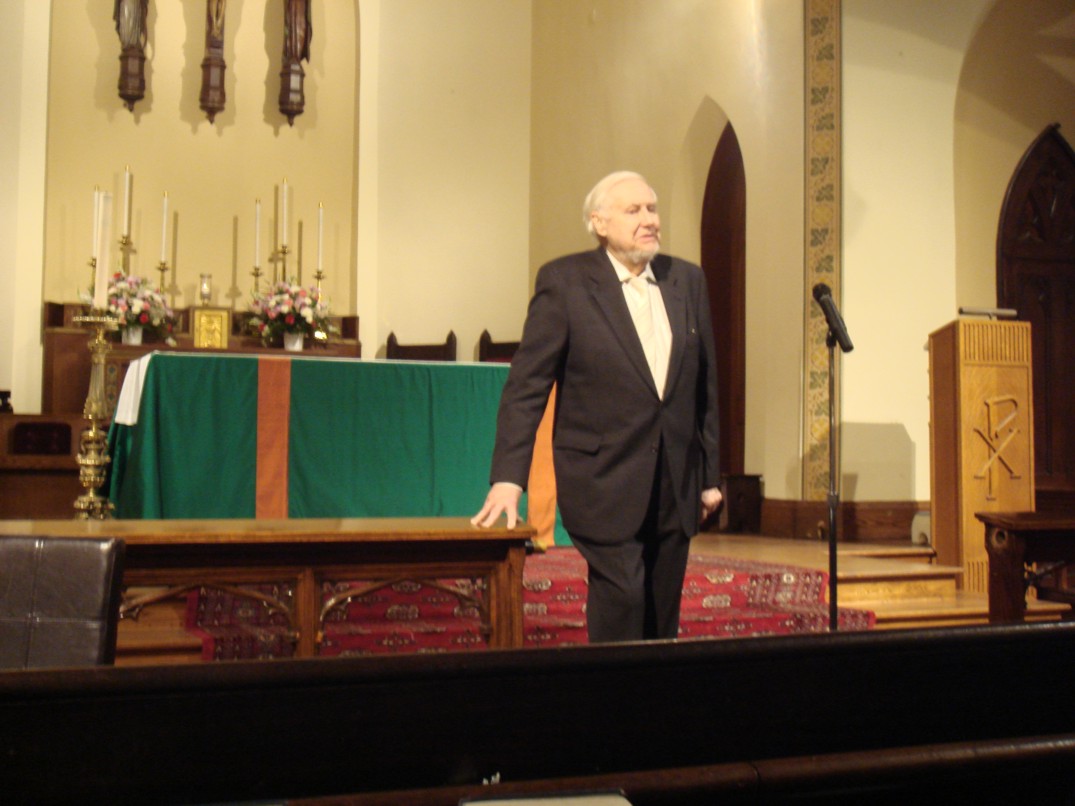
Stewart Manville of the International Percy Grainger Society reminiscing about Percy Grainger. 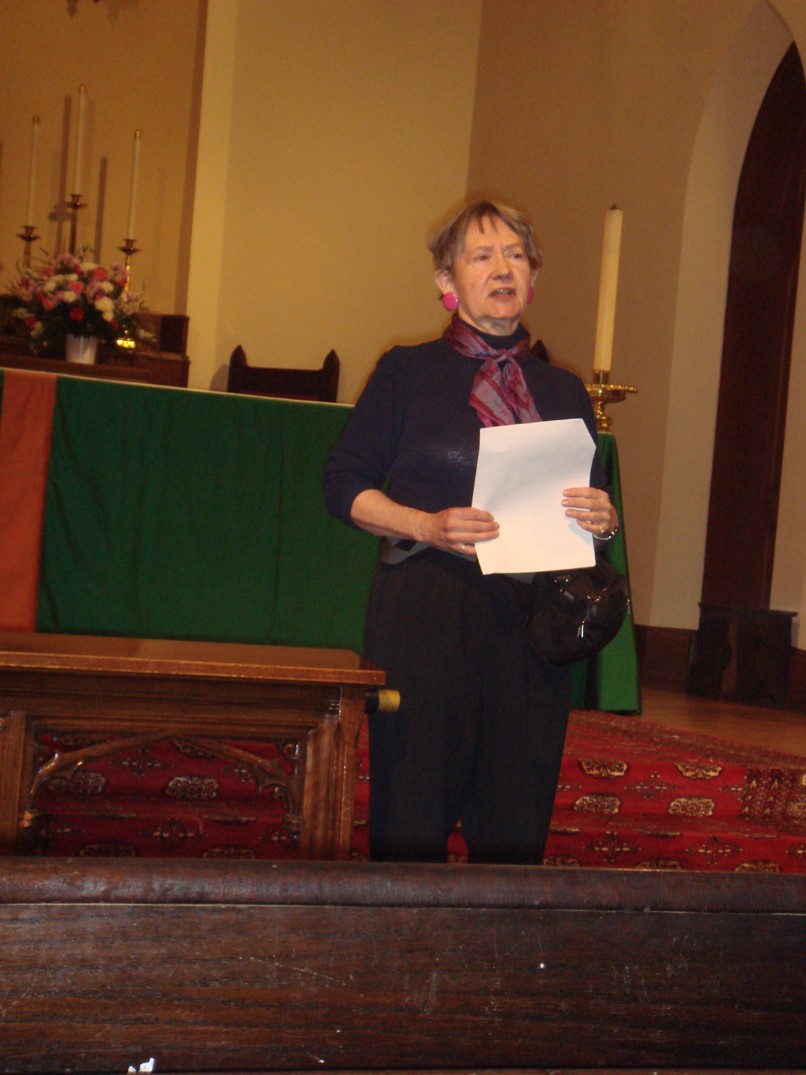 Dr. Cora Sowa of the International Percy Grainger society talking about Grainger's musical heritage. |
|
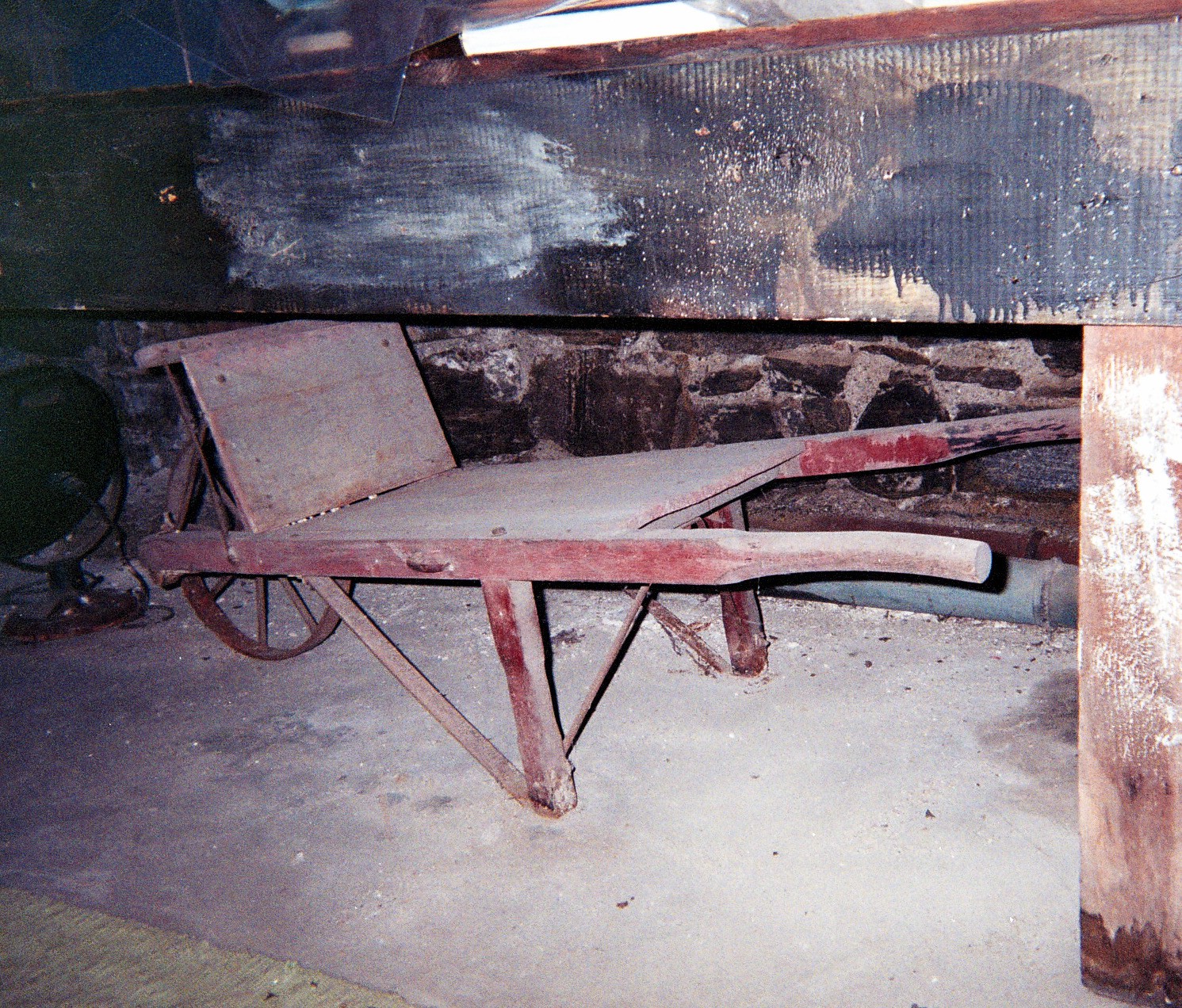
The famous wheelbarrow, on which Grainger wheeled his own and his guests' luggage to and from the White Plains train station. It now sits in the basement of the Grainger House.
GRAINGER HOUSE WELCOMES VISITORS, MAY, 2011,
|
|

Reproducing natural sounds
Percy Grainger considered his concept of "Free Music" (and the experimental machines to create it) to be "his only truly valuable and original contribution to music." (-Margaret Leng Tan, in Thomas P. Lewis, A Source Guide to the Music of Percy Grainger).
Grainger's innovations, which seem avant-garde even today, included work with Hammond organs, piano rolls, electronic sound-producing mechanisms, and hand-built machines to create "free music" (i.e. unconstrained by traditional pitch or beat). His inspirations were the natural sounds of waves lapping aginast a boat, railroad trains, voices, even a squeaking door. These were early forms of music synthesizers. Although he developed, with physicist Burnet Cross, an electronic version of his Free Music machine, he was not interested in electronic music for its own sake, but only as a means to an end, of freeing music from what he considered the shackles of its traditional forms. Nor did he want a performance instrument for the concert hall, but a composing machine that would let him actually hear the sounds that he already heard in his head.
The full-scale Free Music machines can no longer be seen (or heard) at the Grainger House in White Plains, but a small (non-working) model of one of his machines, pictured above, can be seen by visitors to the Grainger House. The full-scale machines, which he called "Tone-Tools," now reside in the Grainger Museum in Melbourne.
Percy's work on his experimental machines, installed in his living room, can be seen in the archival photos reproduced below: (1) Percy's "Kangaroo Pouch" Free Music machine, set up in his living room, ca. 1950, (2) Burnett Cross and Percy working on the Free Music machine, 1951. (From Inez Bull, 7 Cromwell Place: A Loving Tribute to Percy Grainger.)
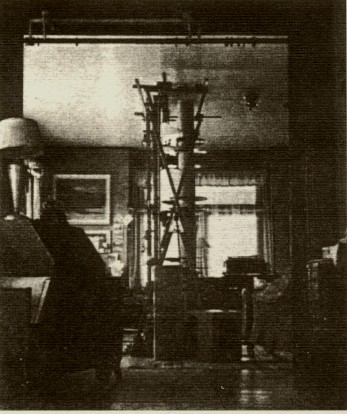

The picture below of Percy and Ella working on one of his machines is reproduced from Thomas P. Lewis, A Source Guide to the music of Percy Grainger.
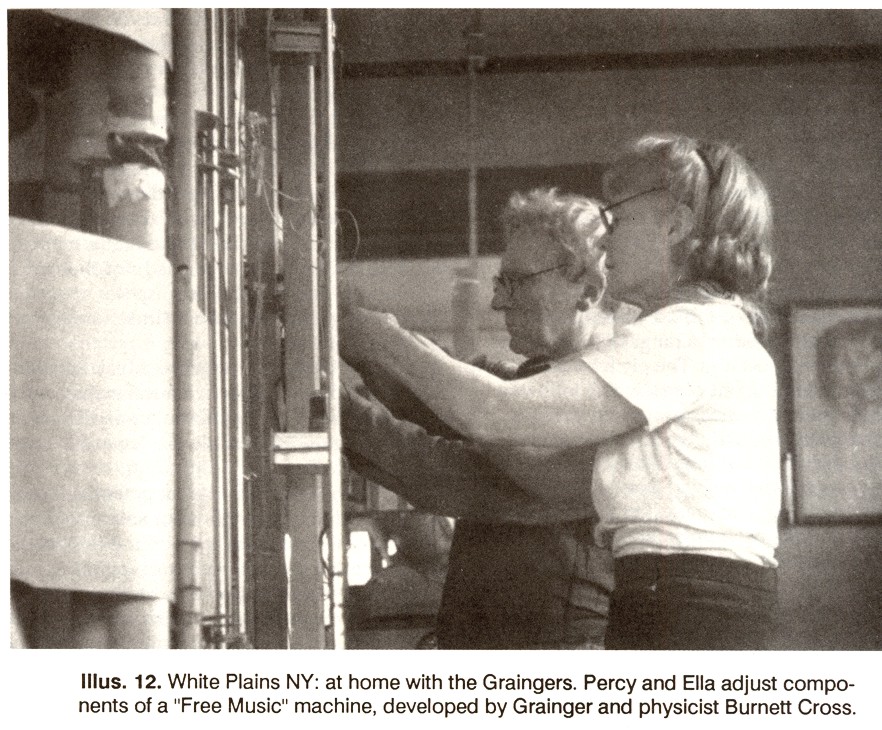
Grainger's Free Music Machine, described by Burnett Cross
The following description by Burnett Cross, of the electronic Free Music Machine developed by Grainger together with Cross, is taken from Thomas P. Lewis, A Source Guide to the Music of Percy Grainger. The diagrams included below are those that illustrate the article. This description and other material about Grainger's variations on this idea, including a long essay by Margaret Leng Tan, is included in the "Program Notes" section of Lewis' book, which is reproduced on this Web site. Click HERE to go to the correct page (look for "Free Music").
_______________________________
"The free music machine had to be able to play any pitch within its range. It was to be free of the limitations of speaking in half tones, or quarter tones or eighth tones for that matter. Any pitch (or group of pitches within the range of the seven voices planned for the machine shown) was to be available to the composer.
"The machine had to be able to go from pitch to pitch by way of a controlled glide as well as by a leap. It was to be free of the limitations of the usual methods of progressing from pitch to pitch.
"The machine had to be able to perform complex irregular rhythms accurately, rhythms much too difficult for human beings to execute. It was to be free of the limitations of the human performer, of what Grainger called `the tyranny of the performer.' Of course dynamics were to be precisely controlled as well.
"The machine had to be workable by the composer. It was not to require a staff of resident engineers to translate the composer's language into the machine's language or to keep the machine in working order.
"This last requirement produced, I think, the most striking feature of the machine developed. Grainger had worked out a form of graph notation for Free Music for many years. The Free Music machine [we] developed `reads' this graph notation, with very little modification required. The pitch control graph and the volume control graph are painted in the appropriate bands on the five-foot wide roll of clear plastic (see Figure 1, preceding page). Black plastic ink is used. By sliding the portion just pain ted across the pitch and volume control slits, the musical result is heard at once, and any adjustments can be made at once. In fact if one paints on the plastic directly over the pitch control slit, one can hear the pitch being formed. Happily the plasti c ink used is water-soluble, so erasure is easy.
"As the pitch-control graph moves across the pitch control slit, it causes the amount of light entering the slit to vary. This light (from the spotlight above) is reflected from a curved mirror to the pitch control photocell (see Figure 2, above). The photocell controls the frequency produced by a transistor oscillator: more light raises the frequency, less light lowers it, and no light at all produces the bottom note of the oscillator range. Thus variations in pitch are obtained.
"The output of the oscillator is sent to a common type of flashlight bulb, one that has a tiny filament and a built-in lens. The bulb changes the pulsating current from the oscillator into a pulsating beam of light. This beam is directed upward throug h the volume control slit, to strike the volume control photocell. The volume control graph varies the amount of light reaching this photocell, which is connected to a preamplifier-amplifier-speaker circuit. Thus the strength of the oscillator output can be varied and control of dynamics achieved.
"Imposing on the pitch control slit a musical scale of whatever sort is desired can be done with the filter and tuning sticks. How these are mounted above the slits, on the tuning bridge, is shown in Figure 3 (above). The tuning bridge rests on the me tal guide-rails that steer the flow of the plastic sheet from roller to roller. A close-up of a filter and tuning sticks is shown in Figure 4 (next page). By sliding pieces of exposed photographic film of different densities into the filter holder, the am ount of light reaching the pitch control slit can be crudely controlled and the range placement of the oscillator roughly established, for that particular voice. Then by moving tuning sticks in or out the effective width of the slit can be varied. Thus ha lf-tone reference points (for example) of the scale can be distributed evenly along the length of the pitch control slit. The narrower the tuning sticks, or in other words the more of them there are along the slit, the finer the adjustment can be. Thanks to transistors in the oscillator and other circuits, the scale imposed is stable enough. Trying to achieve stability with a vacuum tube circuit was a maddening and unsuccessful task. The vacuum tube model turned out to be a very sensitive device for detec ting changes in the characteristics of vacuum tubes by means of changes in a musical scale.
"Since the spotlights are running on AC it might be expected that an AC hum would be the principal musical output of the arrangement, but it turns out that this is not so. Apparently the filament of the spotlight is too massive to transmit 60 cycles p er second. The power supply for the flashlight bulb, however, has to be pretty smooth DC.
"The mirror is made of a strip of copper bent by hand to the desired shape (which was easier than working out the geometry of the thing) and then chrome plated. A sharp focus on the pitch control photocell is not necessary. Both photo-cells were shielded with lightproof black cardboard from stray light. The transistor oscillator circuit produces a reedy and not unpleasant quality: a wide range of tone colors could be produced by manipulating the electronics of the oscillator, but Grainger was not at a ll interested in this at this stage. Command of pitch, duration and intensity were what he wanted, and quality was unimportant.
"The feeder and eater rollers, as Grainger called them, are mounted on skate wheels, which allow a roller to move from side to side to compensate for irregularities in the plastic sheeting. Since the plastic sheet is constrained by the guide rails so that its position relative to the slits will not change, it must be allowed freedom at both ends of its path. An electric motor can be arranged to turn the eater roller by means of a belt, but turning the roller by hand is easy and safe."
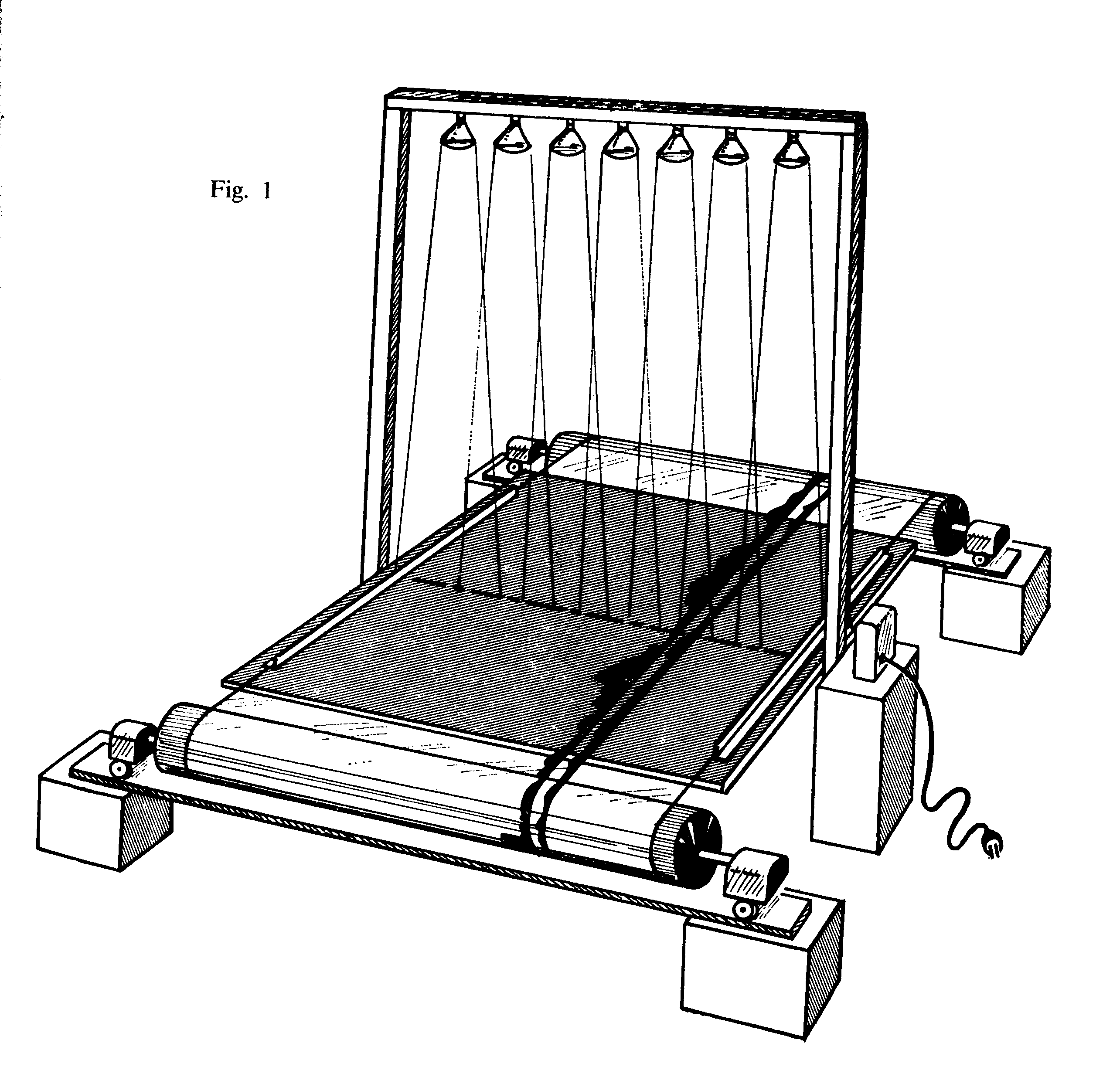



|
|
(Past) News, books, and other announcementsArchived news that previously appeared on this home page, can be found on the Past News and Announcements page. |
|
|
|
|
The International Percy Grainger Society is dedicated to preserving the musical legacy of Australian-American composer Percy Grainger, with his many innovations in composition, in the recording of folk-song, and in the creating of original musical instruments. The Society is headquartered in Grainger's long-time home in White Plains, New York. The Society keeps the Percy Grainger archives, containing Grainger's manuscripts, and owns the copyright to his compositions.
The International Percy Grainger Society was founded by his widow, the Swedish-born painter Ella Ström Grainger, who was its leading spirit until her death in 1979. A great debt for keeping up this legacy is also owed to Mr. Stewart Manville, Archivist and Curator, and to Mr. Rolf Stang, President of the Society.
The house itself, at 7 Cromwell Place in White Plains, was Grainger's last home, where he lived from 1921 (when he bought the house with his mother, Rose) until his death in 1961. From the time of his marriage, in 1928, he lived there with Ella. The house looks as it did when he lived there, with his instruments and other furnishings. It is on the National Register of Historic Places. Grainger scholars, composers, and aficionados are invited there to study Grainger's life and works. Visits can be arranged with the Archivist, Mr. Stewart Manville (see the map below).

Percy and Ella Grainger at the Hammond organ, 1950. From Thomas P. Lewis, A Source Guide to the Music of Percy Grainger.
|
The Society is administered by its Board of Trustees, which meets several times a year. These were the board members in 2018 (some of whom are now emeritus or deceased):
Barry Peter Ould,
President Emeritus
Rolf K. Stang, President Emeritus
Susan Edwards Colson, Vice President and General Secretary,
Acting Treasurer
Mark N. Grant, Vice President (emeritus)
Dana Paul Perna, Secretary (emeritus)
Neely Bruce
Eric Culver
Don Gillespie (deceased)
Matthew McGarrell
Robert S. Simon (emeritus)
Margaret Leng Tan (emerita)
Stewart Manville, Archivist/Curator (deceased)
Cora Angier Sowa,
Webmaster (emerita)
Meetings are held in the Grainger House
Board meetings are usually held in the dining room of the Grainger house, where members sit around the big table at which Percy used to write his music. Here are some pictures taken at our meeting in the fall of 2002 (not everyone was present):
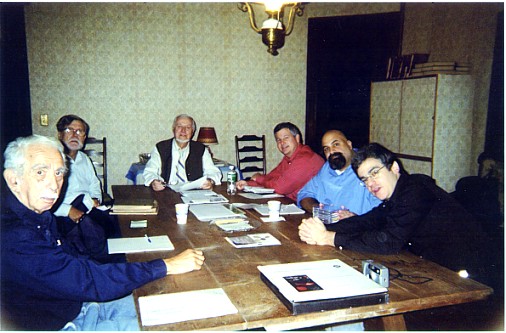
(left to right) (the late) Robert Beckhard, Don Gillespie, Stewart Manville, Robert Simon, Dana Perna, Mark Grant

(clockwise, from left) Stewart Manville, Robert Simon, Dana Perna,
Neely Bruce, Robert Beckhard, Cora Sowa, Don Gillespie
|
Many visitors take a personal tour of the Grainger House at 7 Cromwell (as opposed to the pictorial "virtual tour" offered on this Web site). In 2006, the Society was host to two large groups of musicians: The third weekend in March, some forty members of the Carroll College Wind Band from Wisconsin visited the house, and the following weekend, on March 25, we hosted sixteen music teachers from the College Band Directors' National Association, Eastern Division. Below are some pictures from the band leaders' visit:
Stewart Manville shows off an Edison cylinder recording machine of the kind used by Percy to collect folk songs:

Visiting band directors sign the guest book:

Percy Grainger Society board members Dana Perna and Mark Grant in conversation with Columbia University Wind Ensemble director Andrew Pease:

The visitors also saw the small model of Percy's
Free Music Machine,
pictured above with archival pictures of the full-scale machines.
|
|
About Our Web Site
 |
Grainger information, and other news
This Web site has been designed to bring news of activities of the International Percy Grainger Society, as well as other information concerning Grainger's life and music.
Other pages of this site can be accessed by clicking on the appropriate icons below or on the names on the sidebar down the left of the page. These provide information on the Grainger archives, his cataloged works, membership information, news and announcements. In our "news" category, we like to include the names of new (or newly discovered!) books on Grainger or other materials having to do with Grainger's life and work. The most recent news is put at the top of this home page. Older items are archived on our (Past) News and Announcements" page.
If you have written a book or are giving a a concert or festival that you would like to announce, please contact us.
THE HAUNTED HOUSE: A HALLOWEEN TALE:
|

Is the Grainger House haunted?
For years, there have been reports that the Grainger House is haunted. Musicians composing alone at Percy's own big work table in the dining room have suddenly felt Percy's presence, approving or disapproving, beside them. A former housesitter of reliable and sound mind even claims that he saw objects move on three different occasions: a table leg in the kitchen vibrated; a backpack strap on the second floor oscillated; and a light switch in the basement turned off by itself.
Recently, because of the number of vagrants and other security concerns in the neighborhood, the White Plains police have been making regular rounds about the house. Surveillance cameras have also been installed inside the house.
Strange things are happening
On the night of Saturday, July 2, 2016, another as yet unexplained occurrence was captured on film: something triggered the motion detector in the dining room, once at 8:32, again at 9:23. A lighted object flew across the room, passing out of sight as it left the room. It did not fly like a moth or a bat, and nothing could be found wrong with the camera itself. And a laser beam wouldn't set off the motion detector. Creepy! You can see the videos for yourself by clicking on the links provided below. At the bottom of this item, you will find some screen captures from the first video. In it, the object begins as a tiny dot against a dark background in the upper right hand corner. It grows in size as it passes across the table and exits in the lower left. In the second video, the object flies from left to right. Security camera experts have viewed these films and have offered no scientific explanation.
Who was it?
Was it Percy, testing an inspiration for some new musical device? Was it Ella, resident sprite of the household? Was it Percy's mother Rose, wishing to assert her domination? What do YOU think it was? Click on the links and see the video, or look below for screen captures.
https://video.nest.com/clip/a414fbc0e1c7466a8a3701a50b98da41.mp4
https://video.nest.com/clip/78208f34d9c746f18a90b149b0f6f342.mp4"
Screen shots from the first video
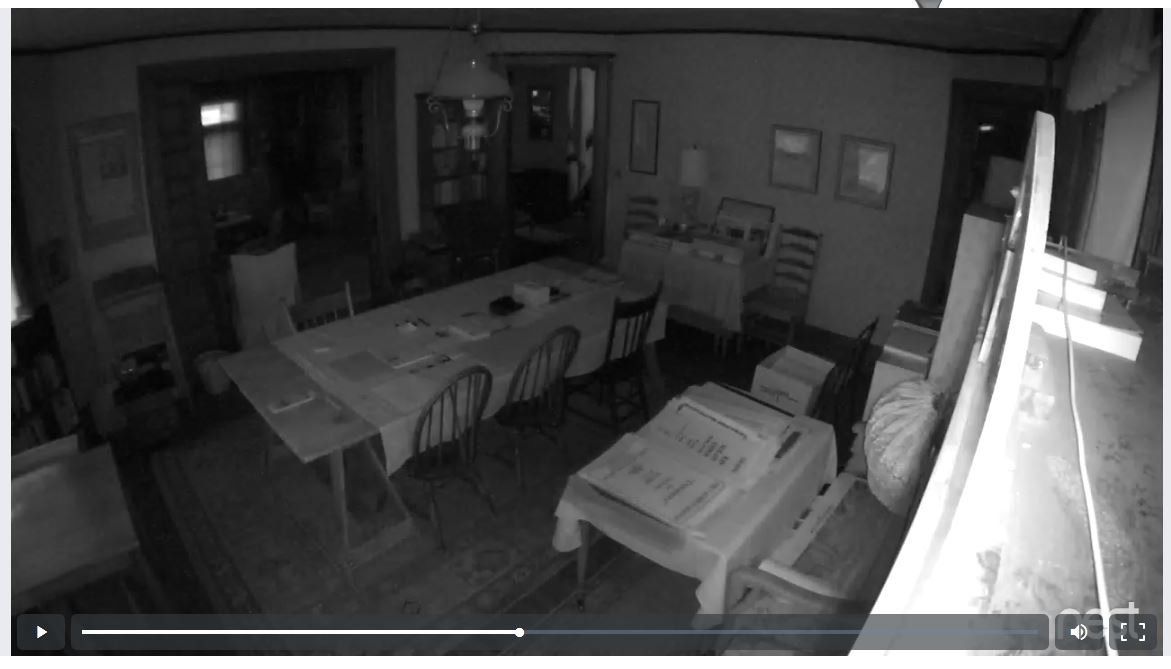
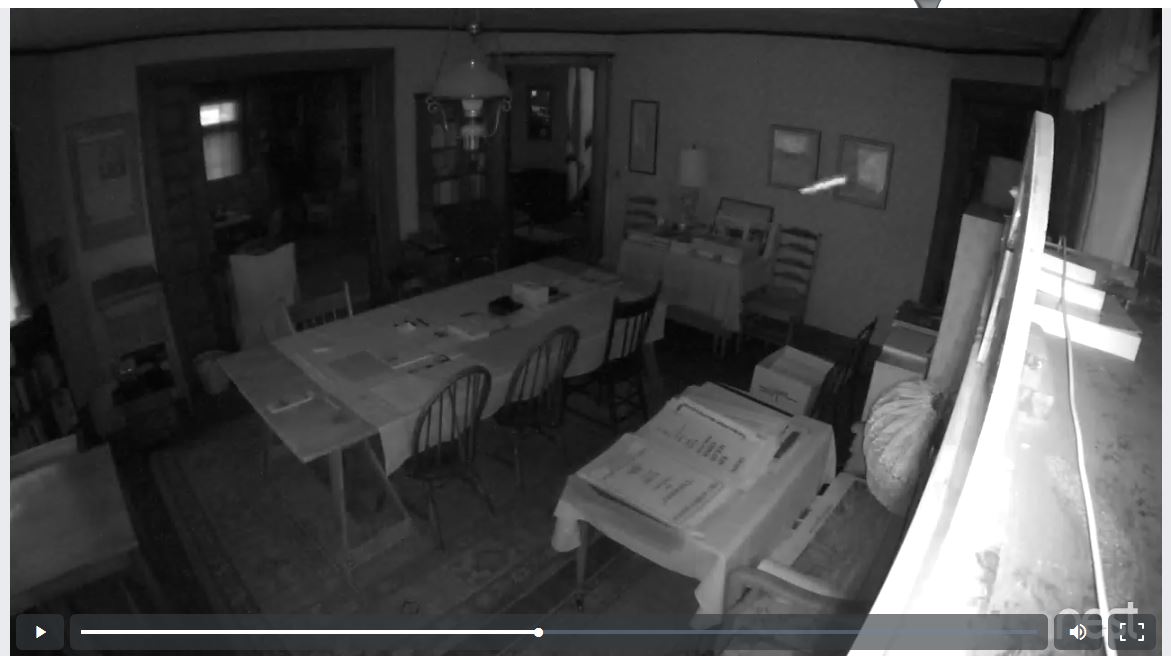

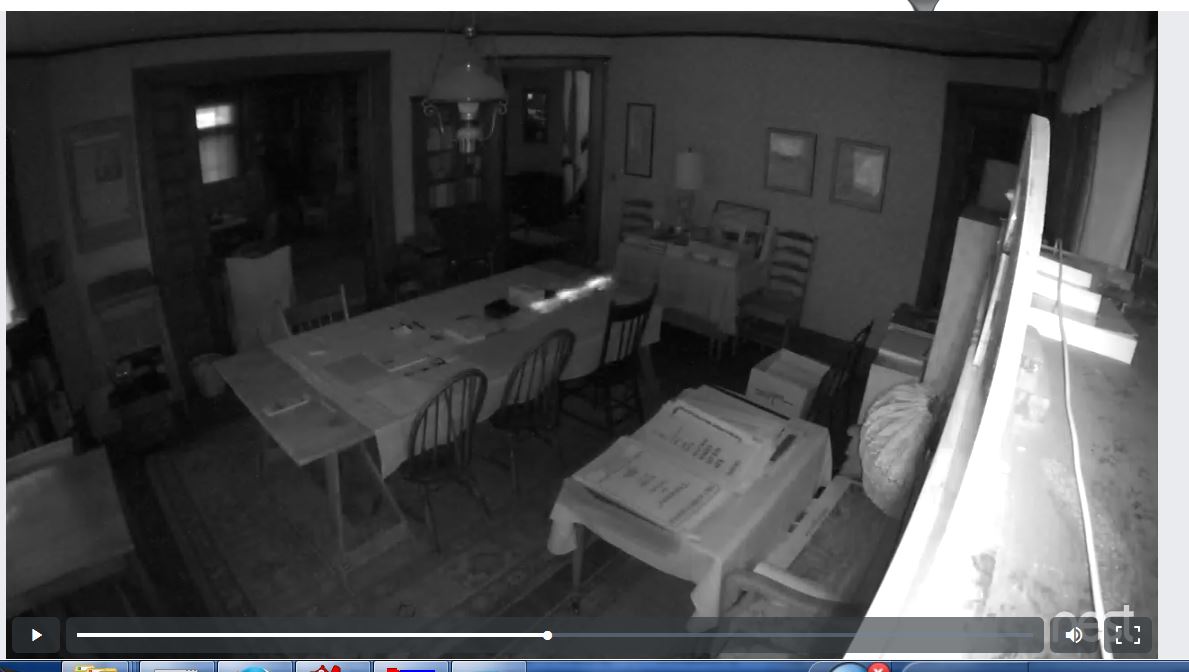
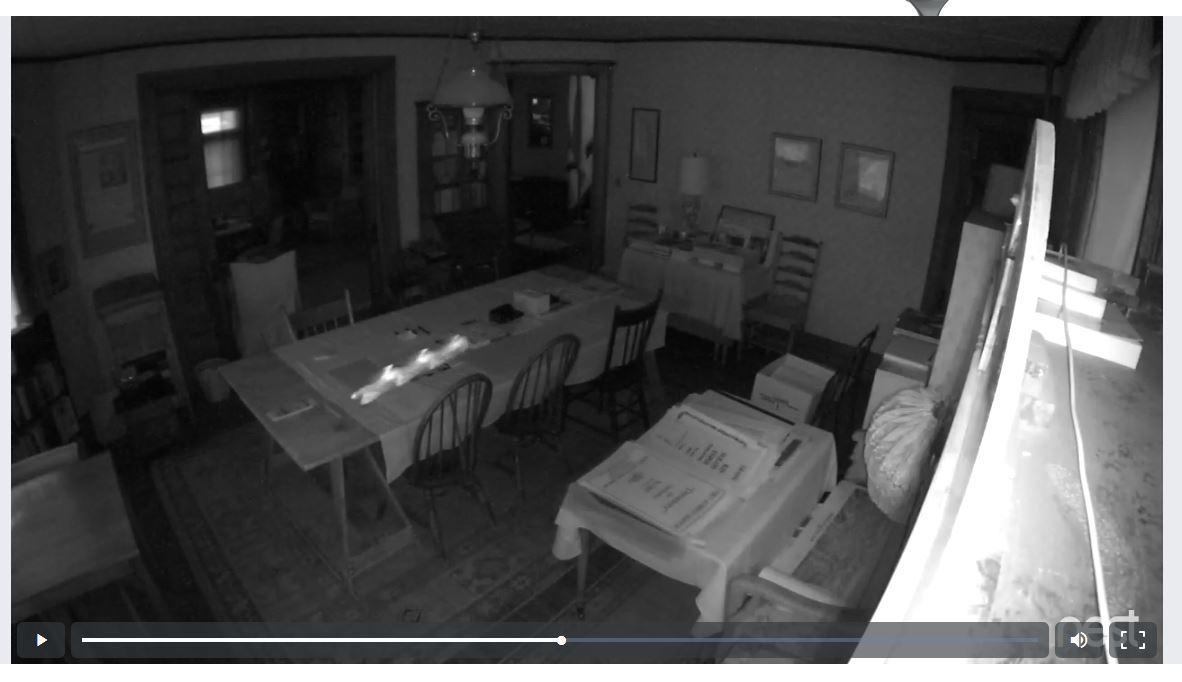
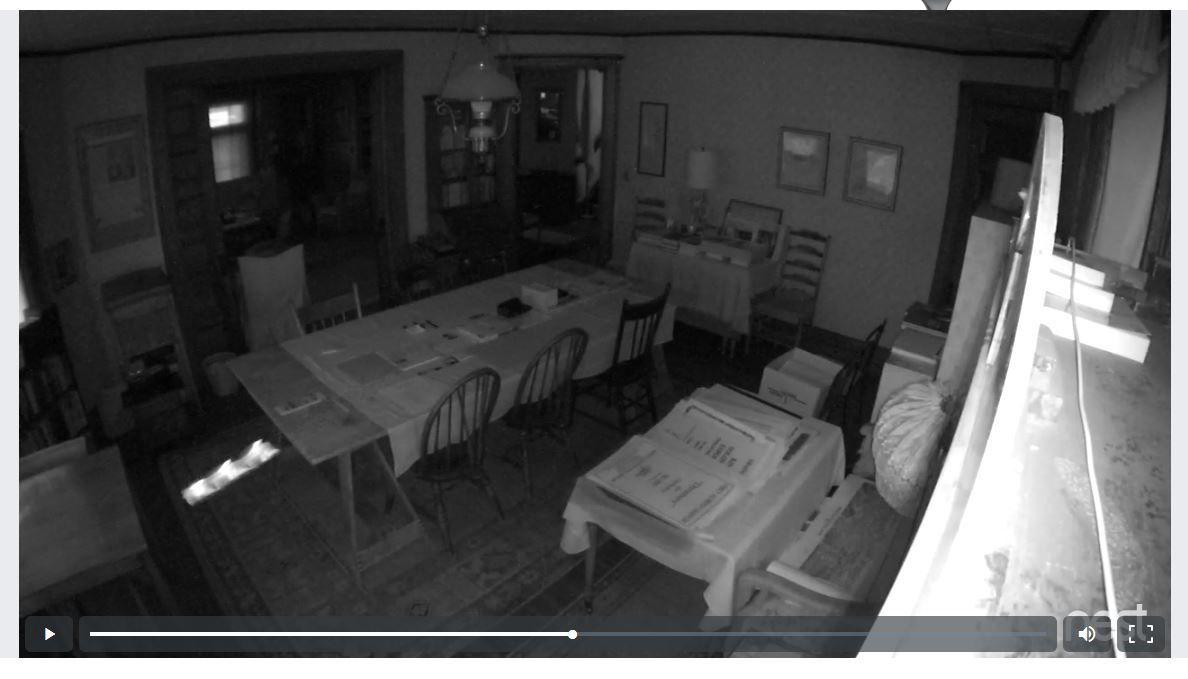
A Source Guide to the Music of Percy Grainger (biographical reminiscences, lists of works, and commentaries) |
Catalogs, commentaries, and biographical essays
A volume of catalogs to Grainger's works, scores, recordings, and other materials, along with "Biographical/Artistic Vignettes" and "Program Notes" or commentaries, has been prepared by Thomas P. Lewis (1991). The "Vignettes" are a collection of essays and reminiscences, both biographical and musical, by friends, colleagues, and students. The biographical/artistic essays and the "Program notes" are perhaps the most valuable parts of the book, since discographies and locations of scores can get out of date and be superseded by more complete listings.
Originally published by Pro/Am Resources, Inc. of White Plains, NY, this volume, or at least parts of it, is being put online, piece by piece. Chapters 1 and 4 are now available to be read on this site. Click on "Biographical/Artistic Vignettes" or "Program Notes" to go directly to these chapters. Or click on A Source Guide to the Music of Percy Grainger or on the reproduction of its cover below to see the complete Table of Contents of the book.

Membership information |
All are invited to become members of the International Percy Grainger
Society. Go to the
new web site to obtain information on how to join.
Other Web sites |
There are other Web sites devoted to the life and work of Percy Grainger. The Percy Grainger Museum in Grainger's native Melbourne, Australia maintains its own site, as do musicians and enthusiasts in the U.K. and other countries. Click to learn about some of these related Web sites.
 This historic Percy Grainger Web site is maintained by Dr. Cora Angier Sowa of
Minerva Systems, an emeritus member of the board of the International Percy
Grainger Society. You can reach her at her Web site
www.minervaclassics.com
or send comments by e-mail to
casowa@aol.com.
This historic Percy Grainger Web site is maintained by Dr. Cora Angier Sowa of
Minerva Systems, an emeritus member of the board of the International Percy
Grainger Society. You can reach her at her Web site
www.minervaclassics.com
or send comments by e-mail to
casowa@aol.com.
On this Web page, you are visitor number:
Last Modified:
